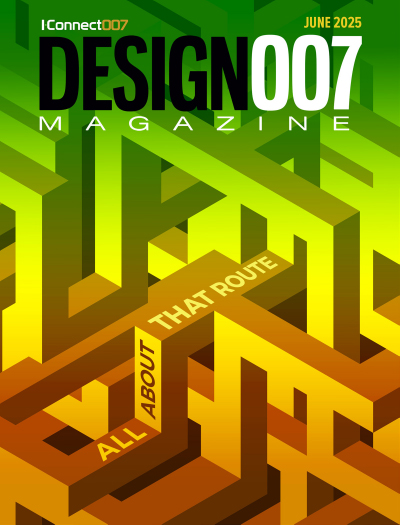-

- News
- Books
Featured Books
- design007 Magazine
Latest Issues
Current Issue
Proper Floor Planning
Floor planning decisions can make or break performance, manufacturability, and timelines. This month’s contributors weigh in with their best practices for proper floor planning and specific strategies to get it right.

Showing Some Constraint
A strong design constraint strategy carefully balances a wide range of electrical and manufacturing trade-offs. This month, we explore the key requirements, common challenges, and best practices behind building an effective constraint strategy.

All About That Route
Most designers favor manual routing, but today's interactive autorouters may be changing designers' minds by allowing users more direct control. In this issue, our expert contributors discuss a variety of manual and autorouting strategies.
- Articles
- Columns
- Links
- Media kit
||| MENU - design007 Magazine
Does Copper Pour on a Signal Layer Decrease Signal-To-Signal Isolation?
April 7, 2022 | Steve Hageman, Analog HomeEstimated reading time: 1 minute
Does putting a ground pour on PCB signal layers make the isolation better or worse? It can go either way, but with the proper knowledge and application, this technique will improve your designs.
In this article, I’ll discuss how to simulate trace-to-trace isolation with true electromagnetic simulation software. We’ll also cover a variety of rules of thumb that can help you stay away from trouble.
Fact or Fiction?
Recently an acquaintance told me, “I have heard that putting a copper pour on a signal layer between traces actually makes the isolation between the traces worse.” I grabbed one of my RF boards and said, “If that is so, then how do all these RF boards that I have done with co-planar waveguide over ground manage to function? They all have copper pours on the signal layer, and they work to very high frequencies.”
Since co-planar waveguide over ground (CPWG), which is essentially “pouring copper on a signal layer,” is used for a lot of RF work, and is proven to work for very high-performance RF circuits, how did this contradictory opinion catch on in the industry?
To investigate this, I used a one-inch section of 50-ohm microstrip consisting of an aggressor trace from ports 1 to 2 and a victim trace running in parallel from ports 3 to 4. I used typical values for the dimensions as might be on a real PCB. The trace width is 20 mils, with a spacing of 60 mils from center to center, over an FR-4 substrate, 9.5 mils thick, with a modeled Er of 4.4.
To read this entire article, which appeared in the March 2022 issue of Design007 Magazine, click here.
Testimonial
"Our marketing partnership with I-Connect007 is already delivering. Just a day after our press release went live, we received a direct inquiry about our updated products!"
Rachael Temple - AlltematedSuggested Items
Trouble in Your Tank: Minimizing Small-via Defects for High-reliability PCBs
08/27/2025 | Michael Carano -- Column: Trouble in Your TankTo quote the comedian Stephen Wright, “If at first you don’t succeed, then skydiving is not for you.” That can be the battle cry when you find that only small-diameter vias are exhibiting voids. Why are small holes more prone to voids than larger vias when processed through electroless copper? There are several reasons.
The Government Circuit: Navigating New Trade Headwinds and New Partnerships
08/25/2025 | Chris Mitchell -- Column: The Government CircuitAs global trade winds continue to howl, the electronics manufacturing industry finds itself at a critical juncture. After months of warnings, the U.S. Government has implemented a broad array of tariff increases, with fresh duties hitting copper-based products, semiconductors, and imports from many nations. On the positive side, tentative trade agreements with Europe, China, Japan, and other nations are providing at least some clarity and counterbalance.
How Good Design Enables Sustainable PCBs
08/21/2025 | Gerry Partida, Summit InterconnectSustainability has become a key focus for PCB companies seeking to reduce waste, conserve energy, and optimize resources. While many discussions on sustainability center around materials or energy-efficient processes, PCB design is an often overlooked factor that lies at the heart of manufacturing. Good design practices, especially those based on established IPC standards, play a central role in enabling sustainable PCB production. By ensuring designs are manufacturable and reliable, engineers can significantly reduce the environmental impact of their products.
50% Copper Tariffs, 100% Chip Uncertainty, and a Truce
08/19/2025 | Andy Shaughnessy, I-Connect007If you’re like me, tariffs were not on your radar screen until a few months ago, but now political rhetoric has turned to presidential action. Tariffs are front-page news with major developments coming directly from the Oval Office. These are not typical times. President Donald Trump campaigned on tariff reform, and he’s now busy revamping America’s tariff policy.
Global PCB Connections: Understanding the General Fabrication Process—A Designer’s Hidden Advantage
08/14/2025 | Markus Voeltz -- Column: Global PCB ConnectionsDesigners don’t need to become fabricators, but understanding the basics of PCB fabrication can save you time, money, and frustration. The more you understand what’s happening on the shop floor, the better you’ll be able to prevent downstream issues. As you move into more advanced designs like HDI, flex circuits, stacked vias, and embedded components, this foundational knowledge becomes even more critical. Remember: the fabricator is your partner.


